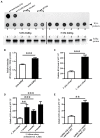Mutation in the RNA-Dependent RNA Polymerase of a Symbiotic Virus Is Associated With the Adaptability of the Viral Host
- PMID: 35432275
- PMCID: PMC9005967
- DOI: 10.3389/fmicb.2022.883436
Mutation in the RNA-Dependent RNA Polymerase of a Symbiotic Virus Is Associated With the Adaptability of the Viral Host
Abstract
Host adaptation has the potential to cause rapid genetic variation in symbiotic microorganisms in insects. How mutations in symbiotic viruses favor viral fitness in hosts and even influence host adaptability to new environments remains elusive. Here, we explored the role of genetic divergence at one site of a symbiotic virus, Acyrthosiphon pisum virus (APV), in the host aphid's adaptation to unfavorable plants. Based on the transcriptomes of the pea aphid Vicia faba colony and Vicia villosa colony, 46 single nucleotide polymorphism (SNP) sites were found in the APV genomes from the two aphid colonies. One SNP at site 5,990, G5990A, located at the RNA-dependent RNA polymerase (RdRp) domain, demonstrated a predominance from G to A when the host aphids were shifted from V. faba to the low-fitness plants V. villosa or Medicago sativa. This SNP resulted in a substitution from serine (S) to asparagine (N) at site 196 in RdRp. Although S196N was predicted to be located at a random coil far away from conserved functional motifs, the polymerase activity of the N196 type of RdRp was increased by 44.5% compared to that of the S196 type. The promoted enzymatic activity of RdRp was associated with a higher replication level of APV, which was beneficial for aphids as APV suppressed plant's resistance reactions toward aphids. The findings showed a novel case in which mutations selected in a symbiotic virus may confer a favor on the host as the host adapts to new environmental conditions.
Keywords: Acyrthosiphon pisum virus; RdRp; pea aphid; polymerase activity; single nucleotide polymorphism; symbiotic virus.
Copyright © 2022 Lu, Li, Yang, Jiang, Liu and Cui.
Conflict of interest statement
The authors declare that the research was conducted in the absence of any commercial or financial relationships that could be construed as a potential conflict of interest.
Figures




Similar articles
-
A Symbiotic Virus Facilitates Aphid Adaptation to Host Plants by Suppressing Jasmonic Acid Responses.Mol Plant Microbe Interact. 2020 Jan;33(1):55-65. doi: 10.1094/MPMI-01-19-0016-R. Epub 2019 Sep 17. Mol Plant Microbe Interact. 2020. PMID: 31184525
-
Enemy-free space promotes maintenance of host races in an aphid species.Oecologia. 2016 Jul;181(3):659-72. doi: 10.1007/s00442-015-3469-1. Epub 2015 Oct 31. Oecologia. 2016. PMID: 26520659
-
Jumping-ship can have its costs: implications of predation and host plant species for the maintenance of pea aphid (Acyrthosiphon pisum Harris) colour polymorphism.Bull Entomol Res. 2013 Oct;103(5):578-83. doi: 10.1017/S0007485313000217. Epub 2013 Apr 22. Bull Entomol Res. 2013. PMID: 23601915
-
Characteristics of acyrthosiphon pisum virus, a newly identified virus infecting the pea aphid.J Invertebr Pathol. 1997 Nov;70(3):169-76. doi: 10.1006/jipa.1997.4691. J Invertebr Pathol. 1997. PMID: 9367722
-
Do plant viruses facilitate their aphid vectors by inducing symptoms that alter behavior and performance?Environ Entomol. 2008 Dec;37(6):1573-81. doi: 10.1603/0046-225x-37.6.1573. Environ Entomol. 2008. PMID: 19161702
Cited by
-
Insect-microbe interactions and their influence on organisms and ecosystems.Ecol Evol. 2024 Jul 21;14(7):e11699. doi: 10.1002/ece3.11699. eCollection 2024 Jul. Ecol Evol. 2024. PMID: 39041011 Free PMC article. Review.
-
The SARS-CoV-2 differential genomic adaptation in response to varying UVindex reveals potential genomic resources for better COVID-19 diagnosis and prevention.Front Microbiol. 2022 Aug 4;13:922393. doi: 10.3389/fmicb.2022.922393. eCollection 2022. Front Microbiol. 2022. PMID: 36016784 Free PMC article.
-
Evolutionary dissection of monkeypox virus: Positive Darwinian selection drives the adaptation of virus-host interaction proteins.Front Cell Infect Microbiol. 2023 Jan 13;12:1083234. doi: 10.3389/fcimb.2022.1083234. eCollection 2022. Front Cell Infect Microbiol. 2023. PMID: 36710983 Free PMC article.
-
A New Variant of Avian Encephalomyelitis Virus Associated with Neurologic Signs in Turkey Poults.Pathogens. 2024 Sep 4;13(9):758. doi: 10.3390/pathogens13090758. Pathogens. 2024. PMID: 39338949 Free PMC article.
References
LinkOut - more resources
Full Text Sources
Research Materials

